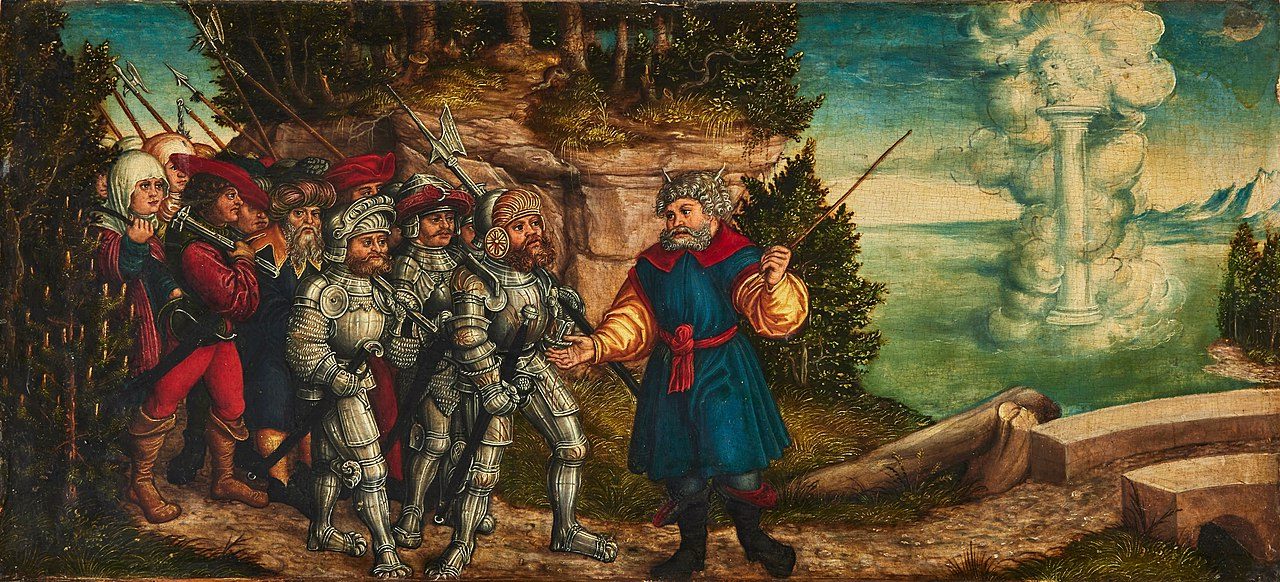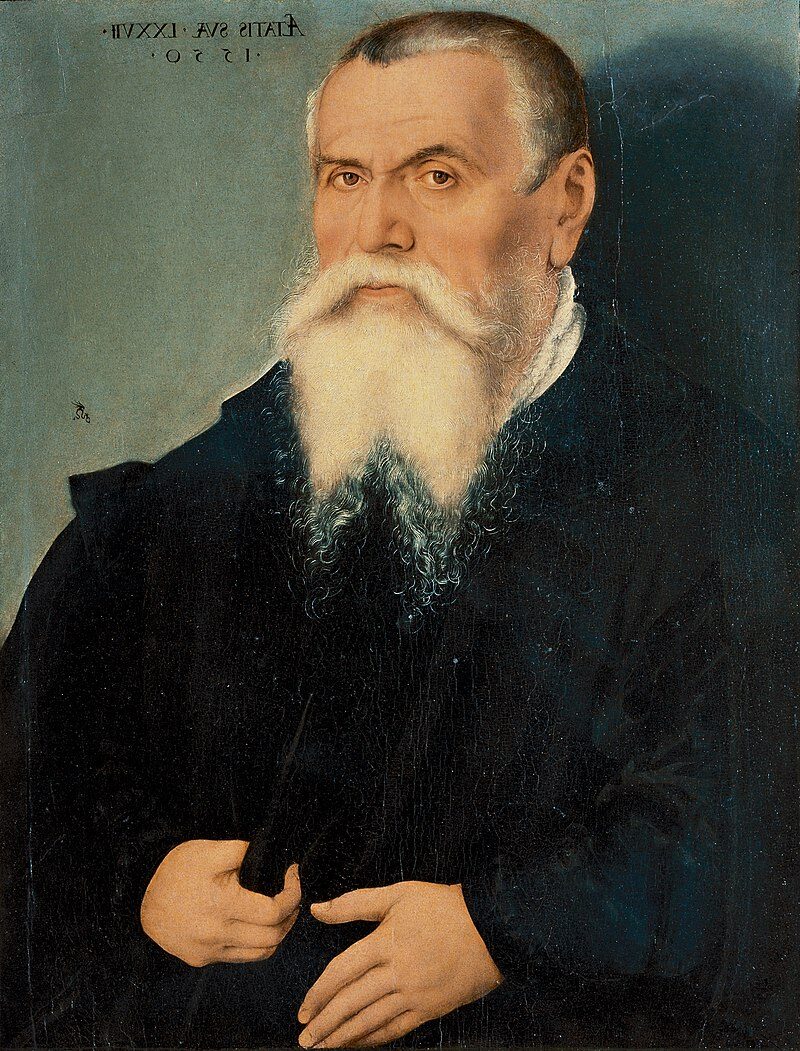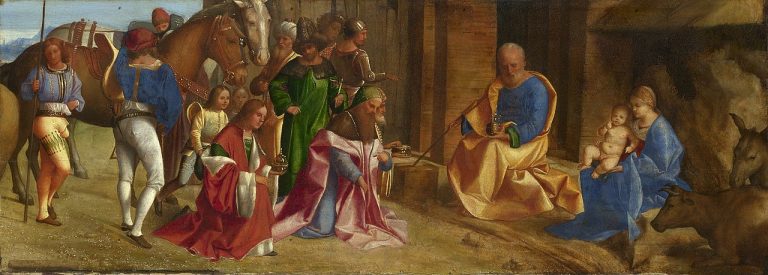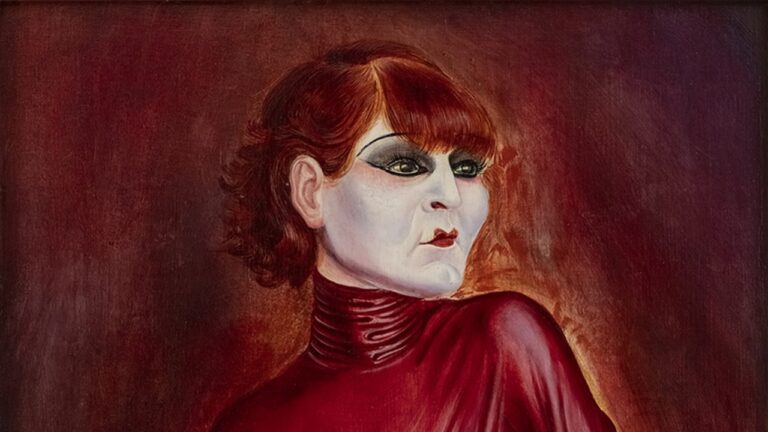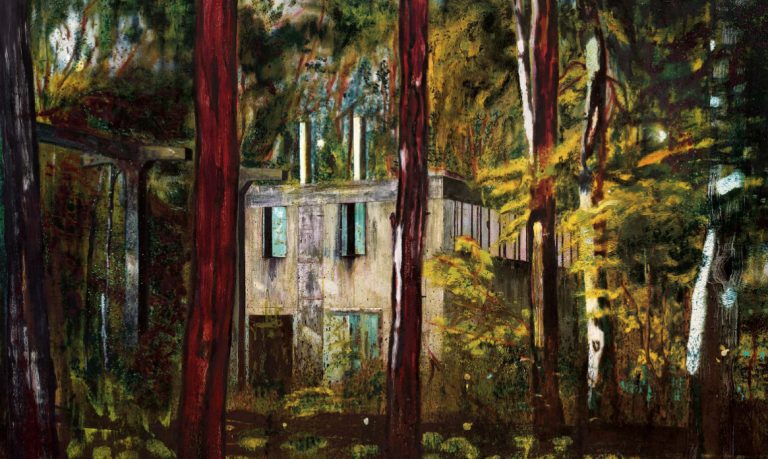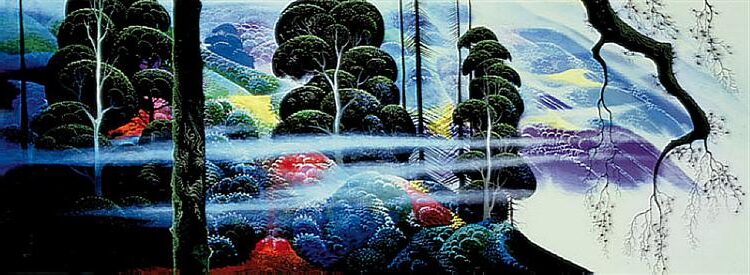Lucas Cranach the Elder: Master Renaissance Painter of German Art
Born: c. 1472, Kronach, Prince-Bishopric of Bamberg, Holy Roman Empire
Death: 16 October 1553, Weimar, Duchy of Saxony, Holy Roman Empire
Art Movement: German Renaissance
Nationality: German
Teacher: Hans Maler (His Father)
Lucas Cranach the Elder: Master Renaissance Painter of German Art
Life and Works of Lucas Cranach the Elder
Lucas Cranach the Elder (1472-1553) emerged as one of the most influential German Renaissance artists through his distinctive style and connections to powerful patrons. His career spanned a pivotal period in European history, during which his artistic talents served both political and religious purposes.
Early Years and Personal Life
Born in 1472 in the Franconian town of Kronach, Lucas Cranach took his surname from his birthplace. Little is known about his early training, though he likely learned from his father, who was also a painter.
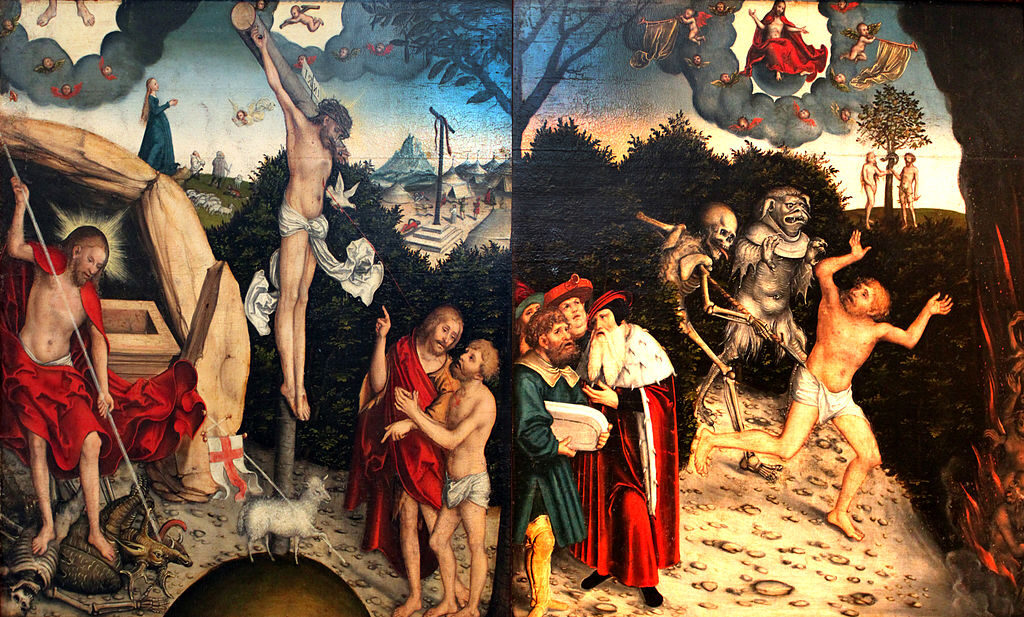
Allegory of Law and Grace (c. 1529) by Lucas Cranach the Elder
By his early thirties, Cranach had developed a distinctive style characterized by elongated figures, vivid colors, and meticulous attention to detail.
In 1512, Cranach married Barbara Brengbier, the daughter of a mayor from Gotha. Together they had several children, including Lucas Cranach the Younger, who would follow in his father’s artistic footsteps.
Cranach established a successful workshop in Wittenberg that produced numerous paintings, altarpieces, and woodcuts. His business acumen matched his artistic talent, allowing him to acquire property and even operate a pharmacy and printing press.
Notable Patronage and Court Painter Role
In 1505, Cranach secured the life-changing position of court painter to Frederick the Wise, Elector of Saxony. This prestigious appointment provided him with steady income and important connections to nobility throughout German-speaking territories.
As court painter, Cranach created numerous portraits of Saxon electors and their families. These works displayed his gift for capturing the essence and status of his subjects through rich details in clothing and jewelry.
Cranach’s workshop became highly efficient, producing art for both religious and secular purposes. Many paintings featured his distinctive winged serpent signature, which became a symbol of quality and authenticity.
His commercial success allowed him to serve as a councilor and eventually mayor of Wittenberg, demonstrating his influence extended beyond artistic circles.
Relationship with Martin Luther and the Reformation
Cranach formed a close friendship with Martin Luther, becoming godfather to Luther’s son. This personal connection placed him at the center of the Protestant Reformation, where his art served the new religious movement’s needs.
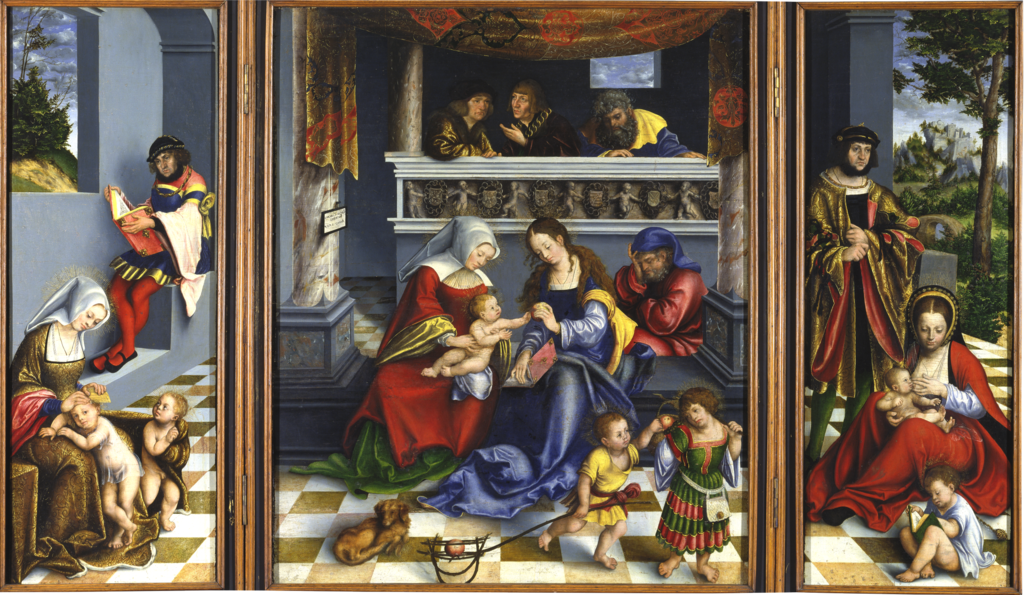
Torgauer Altar (1509) by Lucas Cranach the Elder
His portraits of Luther and reformer Philipp Melanchthon helped spread their likenesses and ideas throughout Germany. Cranach’s woodcuts illustrated Luther’s German translation of the Bible, making religious imagery accessible to ordinary people.
Cranach adapted his religious art to reflect Protestant theology. He moved away from traditional Catholic imagery toward simpler compositions focusing on Biblical narratives and Lutheran themes.
Despite his Protestant connections, Cranach maintained relationships with Catholic patrons, demonstrating his diplomatic abilities during religiously turbulent times.
Legacy and Family: Lucas Cranach the Younger
Lucas Cranach the Younger (1515-1586) trained in his father’s workshop and eventually took over the family business. He maintained the workshop’s distinctive style, making it difficult to distinguish between father and son’s later works.
The Cranach workshop produced over 5,000 paintings, establishing one of the most productive artistic enterprises of the Renaissance. Their distinctive style influenced German art for generations.
After Lucas the Elder’s death in 1553 in Weimar, the younger Cranach continued the family tradition of serving as court painter to Saxon electors.
Today, Cranach’s works hang in major museums worldwide. His paintings of mythological subjects, portraits, and religious scenes demonstrate his versatility and the enduring appeal of his distinctive artistic vision.
Artistic Style and Major Works

Hercules Relieving Atlas of the Globe (c. 1530) by Lucas Cranach the Elder
Lucas Cranach the Elder developed a distinctive artistic style characterized by elongated figures, vibrant colors, and meticulous attention to detail. His vast output spans portraits, religious scenes, and mythological subjects that showcase his versatility as a German painter.
Portraits of Nobility and Influencers
As court painter to the Electors of Saxony for over 50 years, Cranach created numerous portraits of nobility and influential figures. His portraits feature precise lines, rich details, and a remarkable ability to capture the personality of his subjects.
Emperor Charles V was among his notable portrait subjects, highlighting Cranach’s status among European royalty. The artist’s portrait style evolved throughout his career but maintained certain hallmarks—smooth surfaces, delicate features, and elegant poses.
Cranach also produced many portraits of Martin Luther and other Protestant Reformers. These works weren’t merely artistic endeavors but served as powerful tools for spreading Reformation ideas.
His portrait workshop operated with remarkable efficiency, creating a consistent visual language that made his works instantly recognizable throughout German territories.
Religious and Mythological Themes
Cranach’s religious paintings reflect his close connection to the Protestant Reformation. As a friend of Martin Luther, he created visual interpretations of Protestant theology that differed from Catholic traditions.

The Golden Age (1530) by Lucas Cranach the Elder
His altarpieces demonstrate both technical skill and theological understanding. These works often feature simplified compositions with clear messaging—appropriate for the new Protestant emphasis on direct understanding of religious content.
Mythological subjects allowed Cranach to explore sensual themes within acceptable boundaries. His nymphs, Venus figures, and classical scenes blend Northern Renaissance precision with imaginative interpretation of ancient stories.
These works display his mastery of color and composition while revealing Renaissance Germany’s fascination with classical antiquity.
Adam and Eve: Iconographic Achievements
Cranach’s multiple versions of Adam and Eve represent some of his most significant iconographic achievements. He painted this biblical subject throughout his career, creating a distinctive visual approach that became his signature.
These paintings feature slender, graceful figures set against dark backgrounds, often with a black apple tree between them. The serpent typically appears with a human-like face, adding dramatic tension to the scene.
Cranach’s Adam and Eve compositions balance religious meaning with artistic beauty. The figures display both innocence and awareness of their impending fall from grace.
These works demonstrate Cranach’s skill at creating instantly recognizable imagery that communicates complex theological ideas through visual language accessible to viewers of his time.
Cranach’s Influence and Contributions to Arts
Lucas Cranach the Elder shaped German Renaissance art through his innovative techniques, political connections, and religious artwork. His workshop became a powerhouse of artistic production that influenced generations of artists.
Printmaking and the Spread of Work
Cranach excelled as a printmaker, creating woodcuts and engravings that circulated widely across Europe. His printmaking skills allowed his artistic ideas to reach audiences far beyond the Saxon court where he served.
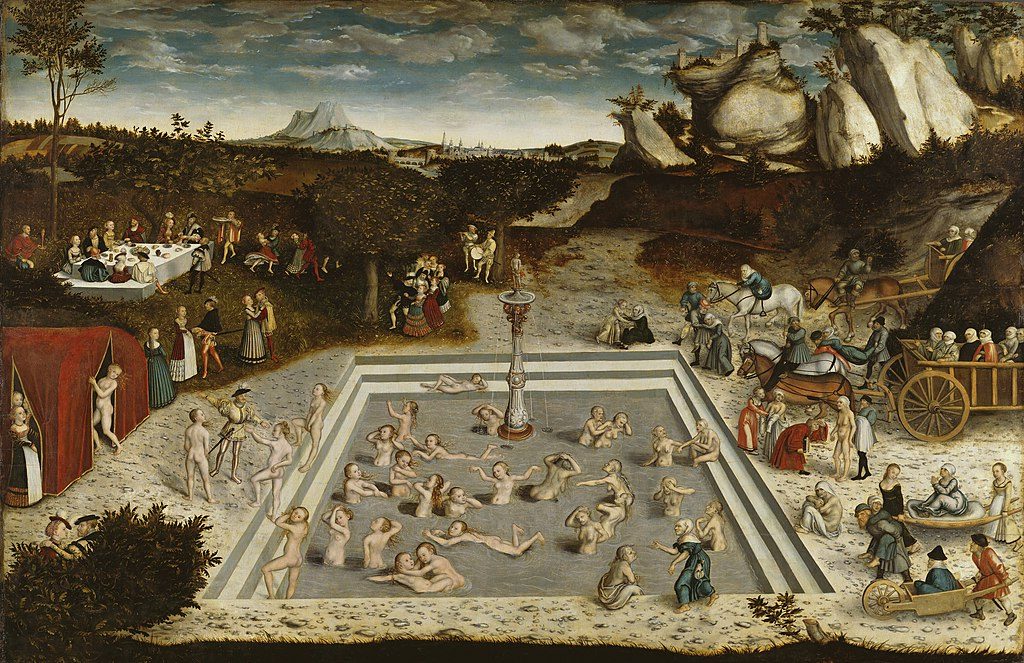
The Fountain of Youth (Der Jungbrunnen) (1546) by Lucas Cranach the Elder
The artist established a large workshop in Wittenberg that produced thousands of prints. These works featured religious subjects, portraits, and mythological scenes that showcased his distinctive style.
As a businessman, Cranach understood the commercial potential of printmaking. He obtained a monopoly on print sales in Electoral Saxony, which helped him build wealth and influence.
His prints were known for their clear lines, expressive figures, and detailed backgrounds. This style became instantly recognizable and influenced many German artists of the period.
Impact on German Renaissance Artistic Trends
Cranach developed a unique artistic language that blended Renaissance techniques with Northern European traditions. His slender figures with small heads, pale skin, and delicate features created a distinctive “Cranach style.”
He pioneered new approaches to religious art that addressed Lutheran concerns while maintaining visual appeal. This helped shape Protestant artistic expression during the Reformation.
His workshop in Wittenberg trained numerous artists who spread his techniques throughout German territories. Many painters adopted elements of his style, particularly in portraiture and religious subjects.
Cranach’s influence extended to Weimar and Gotha, where his works were collected and displayed. Local artists in these cities often imitated his compositions and techniques.
Art and Politics: The Saxon Electorate and Beyond
Cranach served as court painter to three Saxon Electors, creating propaganda art that enhanced their political prestige. His portraits presented these rulers as dignified, powerful figures worthy of respect.
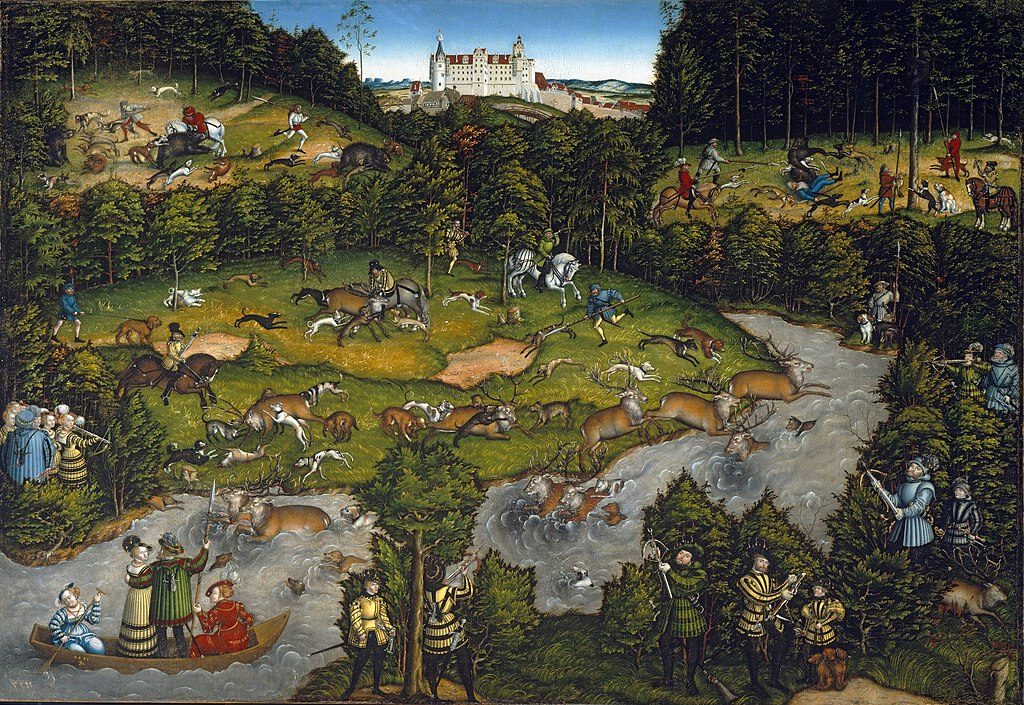
Hunting near Hartenfels Castle (1540) by Lucas Cranach the Elder
Beyond painting, Cranach became a prominent citizen in Wittenberg. He served as mayor multiple times and used his political connections to advance both artistic and business interests.
His friendship with Martin Luther was particularly significant. Cranach created influential portraits of Luther and other Reformation leaders that helped spread their images and ideas.
The artist’s political savvy allowed him to navigate religious changes without losing patronage. He maintained relationships with both Catholic and Protestant clients throughout his career.
Frequently Asked Questions
Lucas Cranach the Elder’s life and work generated significant interest due to his distinctive style, historical impact, and technical innovations. His contributions to art during the German Renaissance period continue to fascinate art historians and enthusiasts alike.
What are the distinguishing characteristics of Lucas Cranach the Elder’s art style?
Cranach’s style is characterized by elongated figures with thin limbs and small heads. His work features vibrant colors and meticulous attention to detail, particularly in clothing and jewelry.
His paintings often include detailed landscapes as backgrounds, showing his skill in depicting nature. Cranach developed a distinctive signature style that included serpents with bat wings, which became his workshop’s trademark.
His portraits capture subjects with psychological insight while maintaining a certain decorative flatness. This combination of realism and stylization makes his work immediately recognizable among German Renaissance artists.
What impact did Lucas Cranach the Elder have on the Protestant Reformation?
Cranach formed a close friendship with Martin Luther and became a significant visual propagandist for the Protestant Reformation. His workshop produced numerous portraits of Luther, his wife Katharina von Bora, and other Protestant reformers.
He created woodcuts and paintings that illustrated Protestant themes and ideas, making complex theological concepts accessible to common people. These visual materials helped spread Reformation ideas throughout German-speaking territories.
Cranach’s paintings often reflected Protestant values, moving away from Catholic iconography toward biblical narratives that emphasized personal faith. His art studio became an important center for disseminating Protestant visual culture.
Can you describe the evolution of Lucas Cranach the Elder’s painting techniques over his career?
Early in his career, Cranach’s work showed influences of the Danube School with atmospheric landscapes and expressive figures. His early paintings featured more naturalistic proportions and looser brushwork.
After becoming court painter in Wittenberg, he developed a more refined, linear style with smoother surfaces. His middle period saw increased workshop production, with the development of efficient techniques for creating multiple versions of popular compositions.
In his later years, Cranach maintained remarkable consistency while gradually allowing more workshop participation in his commissions. Throughout his career, he continued to experiment with painting techniques, including innovative uses of glazes to create luminous effects.
What is the significance of the ‘Adam and Eve’ paintings by Lucas Cranach the Elder?
Cranach painted the Adam and Eve theme numerous times, creating a distinctive interpretation of this biblical subject. These works showcase his ability to portray the human form in an elegant, stylized manner.
The paintings often feature symbolic elements like the apple tree, serpent, and various animals that carry moral and religious meanings. Through these works, Cranach explored theological concepts of temptation, sin, and human nature.
His Adam and Eve paintings became particularly significant during the Reformation era as they addressed fundamental religious questions. The popularity of these works led to multiple versions being produced by his workshop to meet demand.
In what ways did Lucas Cranach the Elder contribute to the development of woodcut printing?
Cranach revolutionized woodcut printing with his clear, precise line work and innovative compositions. He created woodcuts for religious texts, including illustrations for Luther’s translation of the Bible.
His technical mastery allowed for finer detail than many of his contemporaries, elevating the artistic quality of printed materials. Cranach understood how to create designs that would reproduce well in the printing process.
The mass production of his woodcuts helped democratize art, making images accessible to broader audiences. This technical innovation supported the spread of both artistic and religious ideas throughout Germany.
How did Lucas Cranach the Elder’s personal relationships influence his artistic works?
Cranach’s friendship with Martin Luther profoundly shaped his artistic output. It led to numerous portraits and religious works. His position as court painter to the Electors of Saxony secured his status and provided prestigious commissions.
His family connections were also important. His sons, especially Lucas Cranach the Younger, learned his techniques and continued his legacy. The workshop became a family business, with stylistic consistency maintained across generations.
Cranach’s connections to humanist scholars and noble patrons influenced his subject matter and approach. These relationships led to commissions for mythological scenes, portraits, and religious works that reflected the intellectual currents of his time.

